History of NMS 1870-1971
HISTORY OF NEW MARKET SCHOOLS, 1870-1971
Source: "SCOTT, BROWN & UNION TOWNSHIP", "NEW MARKET School" prepared by Charles L. Arvin, April 2000
In order to more fully appreciate the growth and development of education in New Market, one nneds a far different picture of Montgomery County in the 1800's from what it is today. Then the county was sparsely settled; there were few clearings, fewer houses, and no improved roads. New Market, a smal village on the Vandalia Railroad, was built in parts of three townshipd, a fact which could be the reason there was no school building here until about 1870. Other schools had been built in the townships as early as 1830.
SUBSCRIPTION SCHOOL
The first school, about 1870, was financed by subscription (donations by citizens) and was held in a residence in the west part of town on property now owned by Robert Servies (2000). Miss Molly Buchanan was the teacher, but there is no record of how many pupils attended or how many subjects were taught.
THE FIRST SCHOOL BUILDING
As New Market began to grow, the residents realized that school facilities must be established for the purpose of teaching the basic 3R's -- "Readin', Ritin', ans Rithmetic."Some of the citizens donated timber and their labor and in 1873 built a one-room structure approximately where the present elementary building stands. At that time there was one teacher with eight grades requiring abount thirty different recitations in and eight -hour day. Recitations, therefore, could not exceed ten minutes each, and under these conditions there was no chance for the backward child. As the town grew, the school became over-crowded, and in 1881 a room was added on the south.The two rooms were seperated by black-boards, which could be pulled back so that the rooms could be used together as an auditorium. In 1893 a room was added on the north, making the building a three-room school.
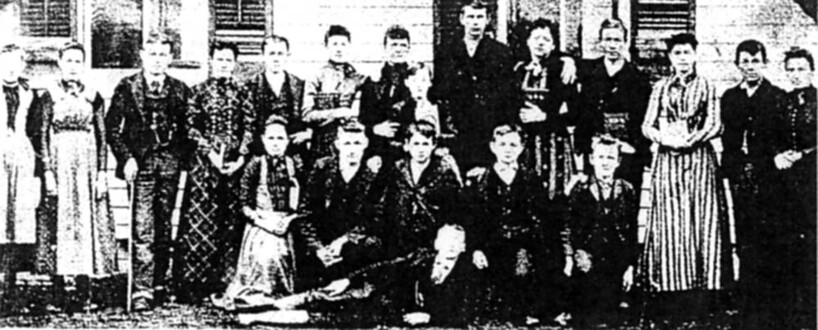
Students of New Market School in 1891
Some of the early teachers were William Bradley. Albert Talbot, C. H. Waldwn, F. W. Howard, Noah Clodfelter, and Charles Kritz. By this time each township had an elected trustee, who in turn selected the teachers. The teachers were paid sometimes with cash, sometimes with donations of food or wood, or sometimes free board and room.
Lessons containing morals and musch poetry were stressed. Eighth grade exams were taken at the county seat. Graduates from the eighth grade received diplomas and gave their Commencement programs, a custom that continued for several years.
In 1873 a County Superintendent's office was created, and the schools from then on became better organized to fulfill their purpose. Teachers were required to be better prepared, and education in general began to make forward strides. A state examination was given to teachers to determine their ability, and more subjects were added to the curriculum. Begining in 1897 two years of high school were offered with one teacher for all high school subjects.
THE SECOND BUILDING
In 1898 the population in and around New Market had so increased that a new building was needed. A two-story brick building of six rooms and basement was erected just east of the present elementary building, on the same lot as the frame structure. This was the first consolidated school in Union Township. Children close to New Market in Scott and Union Townships either walked to school or rode in horse-drawn hacks, but those in Brown Township were required to furnish their own transportation.
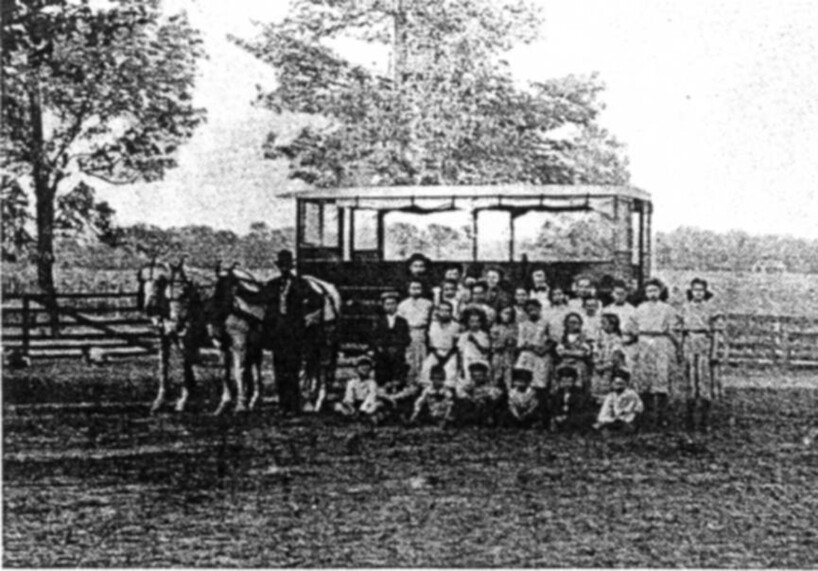
Horse-Drawn Hack to New Market, 1909
The contributor of much of this information has vivid memories of those experiences. She relates: "I came in this category, and I have many memories of cold, stormy days with zero temperatures, six to twelve inches of snow, when only hot bricks on papers with robes piled on top and storm curtains kept me just above the freezing mark. For a fee we kept out horses in a public livery stable during the day, where they were shelted, fed, and watered. When school was over for the day, the livery man had them hitched, and you can imagine about a half dozen `eager steeds' anxious to get home, racing at break-neck speed, with chickens, dogs, and perhaps a few people scattering in all directions. After the first mile, the horses usually slowed down to a steady trot, and then we could ease hold on the reins enough to eat a snack from our lunch (if we were lucky enough to have anything left over) or perhaps to mull over tommorrow's lessons."
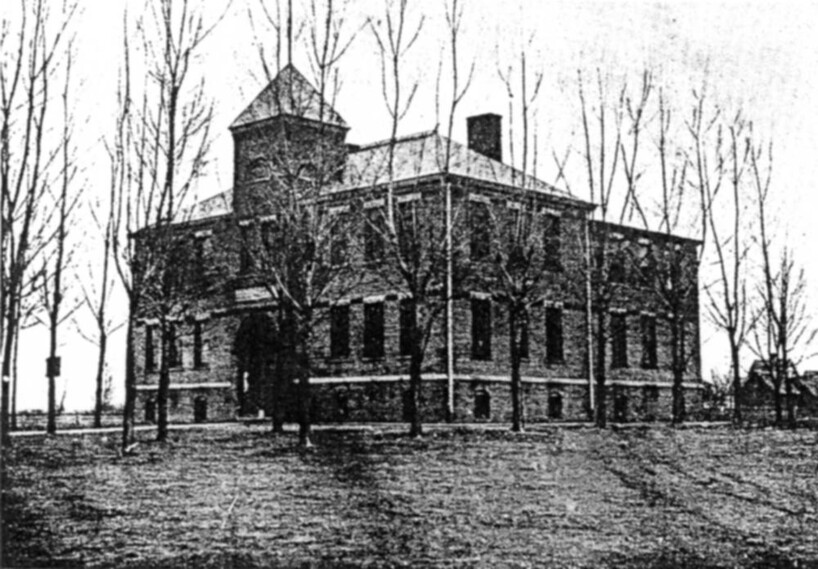
NEW MARKET SCHOOL, 1898-1928
Of the six rooms in this building, four were downstairs and two were up. The lower rooms were used for the first eight grades with two grades to each room and teacher. Some of the early grade school teachers in this building were Molly D. Hall, Edith Gilkey, Julia Brown, Cary Doyel, and Molly Hoover.
Only one of the upstairs rooms was used that first year as there was but one high school teacher, with three years of high school being offered. In 1899 another high school teacher was hired, and both upstairs rooms were used. The following year, 1900-01, marked the begining of four years of high school, and New Market proudly presented its first graduate, Miss Alma VanCleave. During these first few years the established courses of grammer, reading, spelling, arthmetric, and history were studied. Neither music nor art was offered.
In the early years the school functioned somewhat as the "hub" of the community's social events for entertainment was scarce. In the decade 1895-1905, the spelling and ciphering matches, Christmas programs and pie or box suppers were held at the various schools of the county and were well attended by patrons as well as students. To recall the memorable box suppers, or to describe one for the younger generations, the following account is given: "The girls or young maids of the community would would each prepare a box lunch or bake a pie, wrap it decoratively and present it as her admission to the party. After the teacher had presented a program consisting of recitations, ciphering matches, speeches, or whatever his most apt pupils cd to do, the boxes would be sold at auction, incognito, to the spirited bidding of all men and boys present. The boxes had beeen numbered with corresponding numbers given to those who brought them, so when the auction was over, all they had to do was match numbers, seek a cozy corner and enjoy supper with a pretty girl. These affairs were usually climaxed with voting for the prettiest girl present, a penny a vote, which added substantially to the proceeds for the school."
In 1902 New Market became the first commissioned high school in the county, thereby making the graduates more qualified to enter the teaching field or to attend college.
Administrators to serve New Market School during the period 1896-1920 were Messrs. Sam Watson, Vanscoyoc, Harding, Lookabill, TY Hall, Alva Ford, NC Neal, Earl Gifford, Smith, Kellem, Dykes and Kessler.
During the early 1900s the curriculum was expanded to include English literature, ancient history, Latin, music and art. Manual training was added in 1912, a course in domestic science was included about 1916 and commerce in 1918. The year 1919 marked the beginning of the junior high department.
The senior class of 1909 published the first yearbook, the Delphian. No other class undertook the responsibility until 1915 when a larger edition, also called the Delphian was published. As far as can be determined, these were the only two yearbooks until 1946. No record can be found to determine when the school colors of purple and white were adopted, but the 1909 Delphian records their use in that year.
Athletics in New Market had its beginning back in the early 1900s although it was not included in the high school curriculum until much later. The earliest basketball team on record was the one of 1904 with participants Roy Demoret, newton Busenbark, Clay Rice, Harry Galey, Fern Busenbark, L.D. McMullen and Ed Groves. The first officially organized basketball team was that of 1908-09 composed of Byron Miller, Claude Martin, Ralph Bell, Frank Proctor and Everett Long and coached by the school principal, Mr. N.C. Neal.
Basketball played then was much different from the game of today. Then there were few fouls, which was good because the 1909 team had no substitutes. Uniforms of that day also were quite different from those of today. In reality they were more like the modern football uniforms with padded knee-length trousers. Facilities have changed also. Since there were no indoor facilities, gaves were played on outdoor courts located about where the present elementary building stands. Due to weather conditions, basketball was played mostly in the spring and fall months. Later, the Interurban Station at Crawfordsville was used during the winter months but the outdoor courts continued to be used in the spring and fall.
In 1916 the towns people erected a Community Building about a half block south of the present school which was known to many people as "the Coliseum." The school used this building for recreational purposes and extracurricular activities and all basketball games were played there. Outswtanding teams for this period were the teams of 1915 composed of Sam Fairfield, Arthur Caplinger, Ernest Yount, Lloyd ETters, Wayne Gross, Clay Petty and Herman Sayler and 1918 composed of Lloyd Etter, Roy Etters, Noble Warbritton, Russell Bowers, Alva Davis, Foster Seaman and Eddie Stewart.
Girls, too, played basketball during those early years for there is evidence of a girls' team in 1908-009 and again in 1914-15.
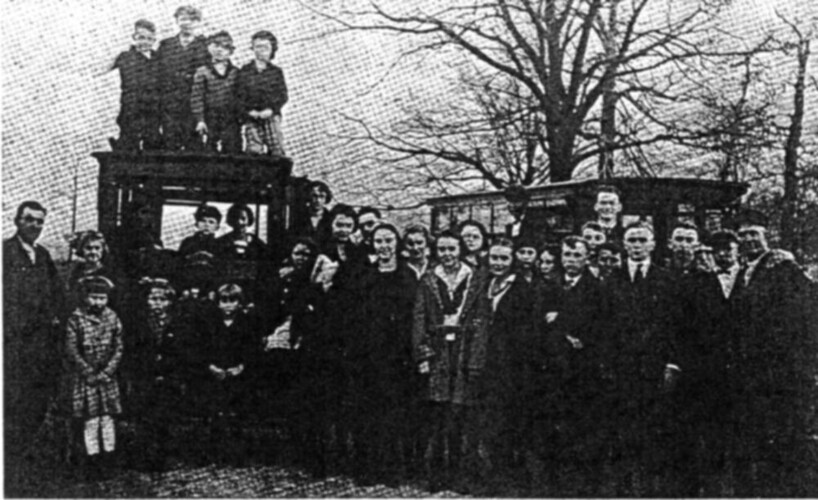
FIRST BUS to New Market High School 1921. John Smith, on left with grade
school bus and Charles Nichols, on right, with high school bus.
THE YEARS 1920-1940
Mr. H.M. Derby served as principal from 1920-24. By 1920 many of the township schools had been closed, and the students were being transported to New Market. The first school bus was usedin 1921, driven by Charles Nichols from Scott Township. In 1921 the over-crowded building made it necessary to hold the domestic science and commerce classes in a house across the street west and to the right of the school. In 1923 the domestic science class was held in the basement of the school, and in 192 and 1927 the commerce classes and second grade met in the house direct across the street.
Mr. Derby was followed by Mr. E.O. Kirkpatrick, who served as principal until 1944 and who held the position longer than any other principal in the entire history of the school. Mr. Kirkpatrick proved to be an outstanding organizer, counselor, and school executive and is fondly remembered by the many students oaf this twenty-year period.
Both the academic and athletic programs continued to be improved. During the 1920s oratory was stressed and greatly influenced by Dr. Brigance of Wabash College. New Market students actively participated in oratorical contests and received high placings. Debate was introduced in 1926 and both a negative and an affirmative team debated with schools within a forty mile radius. However, in a few years both were dropped from the curriculum and did not become a part of it again until the 1950s when speech was added.
Plays were outstanding events during this period. In the music department vocal music took precedence over instrument music, for the newly organized orchestra in 1924 was composed of only six instrument: one saxophone, two violins, two cornets and a piano.
The first school paper, the Booster, was published by the junior class in 1924-25. It continued in existence for aobut three years, and there seems to be no other record of high school papers until 1957.
Baseball had been added in 1921, but because of lack of interest and no coaches, it did not become a part of the athletic program until 1934-35. Basketball continued to be the major sport, but it was not until 1922 that the first basketball coach, Basil Merrill was hired. Other coaches to serve during the 1920s were Bill Herdick and Herman (Jimmy) Ward.
By the middle 1920s the 1898 brick building was considered a fire hazard and also failed to accomodate the increased enrollment. In order to meet this problem, special state legislation was required because of the school'[s unique situation of serving students from three townships. Representatives from the three townships and County Superintendent Merle Coons made several trips to Indianapolis during the time the legislature was in session, and as a result the Joint School Act of 1927 was passed, authorizing the three townships to form a corporation. The three township and the COunty Superintendent served as a Board of Education.
A new twenty-room brick building was constructed in 1928 to accomodate 250-300 students in grades 1-12 and the school was renamed New Market Joint School. The Coliseum, which had been used for extracurricular activities and basketball games now began to lose its place of value in the community and was finally torn down in 1934.,
New Market was the first school in the county to service hot lunches. The program was initiated in 1932 when Mr Kirkpatrick realized that children were coming to school without any lunch. FOr about two years milk in one-half pint bottles was distributed free at the lunch hour. The cost was assumed by concerned organizations in the community. In the fall of 1934 th ehot lunch program was begun. Financing th eprogram was the major problem and the initial money to get it started had to be borrowed. FOr several years patrons donated food and mother's took turns helping in the kitchen in order to make the program a success. Eventually full-time help was employed.
Students from the out-dated township schools continued to come to New Market. In 1935 Parkersburg, the last Scott Township grade school was closed and in 1936 Wilson Grade School in Union Township was terminated.
Two new sports were added to the athletic program during the 1930s. Track was organized in 1933-34 and two outstanding athletes emerged during this period. In 1935 Chester Kessler won the 440 yard dash in 52.5 seconds to set a school record which has not yet been broken and the same year he represented New Market in the Indiana State HS Track Meet where he placed 4th in the quarter-mile. The following year, 1936, Bob Duncan set the 5-minute mile record in the county which held for aobut 18 years. The other new sport to be added, baseball was also organized in 1933-34. The first games were played in the fall of 1934 with New Market winning the first County Baseball Championship.
Two outstanding coaches guided New Market athletes during the 1930s - Russell (Salty) Bowers, 1929-1938 and Harold (Jack) Hester, 1938-1943. During the time that Mr. Bowers was coach, New Market had strong basketball teams throughout the season but was never able to claim a tourney victory; however, he produced an athlete, Jack Hester, who did the very thing in one year that Mr. Bowers said he had tried to do in nine, for Mr. Hester's 139 team won New Market's first Montgomery County Basketball Championship. The same year his baseball team won the County Baseball title, New Market's second.
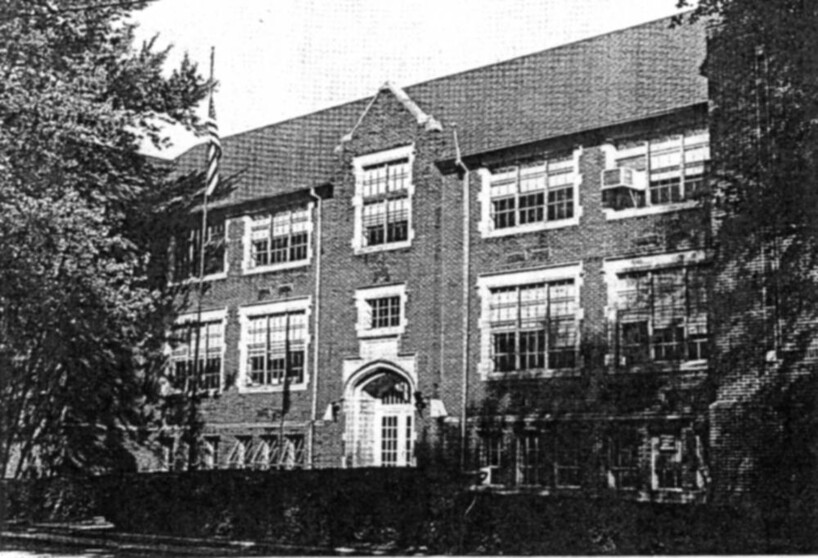
NEW MARKET HIGH SCHOOL, 1928-1957
THE YEARS 1940-1970
During the period 1939-1943 basketball enthusiasm at New Market was at an all-time high. The spirit of the pep sessions held in the assembly for all 12 grades has never quite been duplicated, the team members were particularly determined, and the coach, Mr. Hester was equally determined and respected. As a result, Mr. Hester's teams won four out of five Montgomery County Basketball Championships, 1939, 1940, 1941, and 1943.
Vocational agriculture was added to the curriculum in 1939 but since there was no room for these classes in the main building, a house across the street was rented for this purpose from 1939 to 1941. In 1941 an addition was built onto the existing building to house the agriculture and shop classes and to provide a room for the newly organized band.
The Sunshinne Society, a state philanthropic organization for high school girls, was organized in 1940-41. Throughout the years the organization has been sponsored by the home economics teacher and has always been active both in the community and in attending district and state conventions.
Five additional acres directly north of the school were purchased in 1944 for necessary playground room to meet the increased enrollment. Former teacher EP Cassidy returned to new Market in 1944 to serve as principal, a position he held until 1954. During these years improvements were made in the mathematics and commerce departments by the addition of new courses. In 1944 a Studemnt Council was organized, the membership of which consisted of two representatives from each class - one elected by the class and one appointed by the faculty.
Prior to 1946 the music department and the art department were combined, a situation causing the teacher to be greatly over-worked. Many after-school hours were spent, particularly from 1924-45 by Mrs. Ruth Elmore Allison, in music instruction and in preparation for entertainment in the community. Until about 1940 vocal music had been given more emphasis than instrumental, but during the early 1940s the orchestra emerged into a band of 25 members and music emphasis was more evenly divided. Though the band was small in size, and during the first few years included even sixth graders, its presentations were outstanding and praised. The band played at ballgames and graduations and gave concerts, and ensembles furnished music for other school functions and many programs in the community. In 1946 a Band Parents Organization was formed, its main purpose being to make money for uniforms, which were used for the first time in 1946-47. Through the years this organization has helped in the purchase of the larger band instruments and new uniforms.
Merle O. Bucklew followed Mrs. Allison as music director from 1946-1958. During the 1940s and 1950s the band participated in many parades and concerts away from the school in addition to the winter school activites and the summer weekly concerts, winning wide recognition for its excellent performances. Some of the events in which the band participated include the Indiana State Fair Farmers Day Parade, 1947 (First Prize) and 1948; President's Parade at Indianapolis, 1948; Riverview Tournament of Bands at Chicago, 1948, 1949; Chicago Railroad fair, 1949; Sesquicentennial Flag Dag Celebration, Washington, DC 1950; "500" Festival Parade, 1960 (Honor Award); Band O'Rama, Indianapolis Raceway Park, 1962; VA Hospital Fair Parade, Danville, Illinois, 1964; State Contests, First Division Rating, 1949 through 1955 and 1959; Coney Island Festivals, Cincinnati, Ohio 1966 through 1970; and Band Day at many Purdue, Indiana University and DePauw football games. The high school chorus also won First Division Rating in 1955, 1957 and 1960.
Interest in athletics continued. Leland (Bill) Melvin came to New Market as coach in 1946 and his first team was the last one to play on the 1928 gym. Because of the inadquate seating and the lack of standard qualifications of the gym, the high school basketball games were played at the Crawfordsville Armory from 1947 until the present high school was builg in 1957. Mr. Melvin coached the Flyers to their third County Baseball School was built in 1957. Mr. Melvin coached the Flyers to their third County Baseball Championship in 1948 and their first Basketball Sectional as well as the fourth County Baseball Championship in 1948 and their first Basketball Sectional as well as the fourth County Baseball Championship in 1950. The junior high basketball team, coached by Charles DeBusk, also won their first Montgomery County Basketball Championship in 1950. The Flyers, coached by Larry Robison were Count Basketball Champs again in 1958.
Bob J. Tandy guided the Flyer athletic teams from 1959 until 1963, at which time he resigned his coaching duties to become principal. Under Mr. Tandy's direction, the Flyers won the County Baseball title and the Big Four Conference Track Championship in 1960, County Baseball Championship in 1961 and the County Basketball title and Big Four Track COnference Championship in 1962. Also in 1962 New Market was represented in the State Track Finals by Joe Chamness who placed 5th in pole vault.
Jack Hester returned as coach in 1963 and directed the Flyers to the County Track Championship in 1964 and their 7th County Basketball title in 1966. Of these seven county basketball championships, Mr. Hester had coached five of the teams.
Football had been added to the sports program in 1958 with Hartsell Newell being the first football coach. Six-man football was played in 1958 and 1959, eight-man football form 1960 to 1963 and the conventional 11-man team initiated in 1963.
The academic program continued to be improved during the 1940s and 1950s. The school year had been eight months until 1946 and 1946 to 1958 it was eight and one-half months and in 1958 extended to nine months. Speech was added in the English department and New Market has participated in all Montgomery County Speech Contests since their beginning in 1958, winning the contests in 1963, 1946, 1954, 1967 and 1968. Several students have participated in the sectional and regional speech contests competing with students from Crawfordsville, Lafayette, Greencastle, Kokomo and Frankfort.
In 1946 the FLYER, the first yearbook since 1915, was published by the junior class. The responsibility was assumed the following year by the same group, as seniors and has remained a senior project each yyear since. In 1957 the HI-FLYER, the first high school paper since 1927, was published by the senior English class and continued to be published until 1966.
The Whitesville Grade School had been closed in 1951 with part of the students coming to New Market that year and during the next few years a gradual transfer of other former Whitesville students from East Union to New Market. The 1928 structure buily for 250-300 students housed 394 in 1955. Over-crowded conditions and lack of adequate facillities resulted in the construction of a new high school on acreage north of the building. This new one-story building was dedicated in October 1957. New courses were offered and the students had better-equipped labs in which to work. The 1928 building was now used entirely by the elementary with grades 1-3 on the first floor and grades 4-6 on the second.
The Indiana School Reorganization Act of 1959 resulted in the creation in 1966 of three school units in Montgomery County = the Crawfordsville City Schools, North Montgomery Community School Corporation and South Montgomery Community School Corporation. The schools are now under the administration of a school board elected by the voters which in turn hires a school superintendent and an assistant superintendent. The Reorganization Act also resulted in the closing of the Alamo School in 1968 and the transfer of approximately 60 students to New Market (part also going to Waveland).
School enrollment continued to grow. From 460 (168 elementary, 192 high school) in 1957 it has grown to 668 (382 elementary, 286 high school) in 1966 and to 864 (471 elementary, 393 high school) in 1970-71. Again, the over-crowded conditions and the demand of society for more adequate education resulted in the construction in 1971 of a new high school, Southmont, for students formerly attending Ladoga, New Market, New Ross and Waveland high schools. New Market had seen the closing of many township grade schools, but the time had come for New Market itself to become a part of a larger consolidatoin.
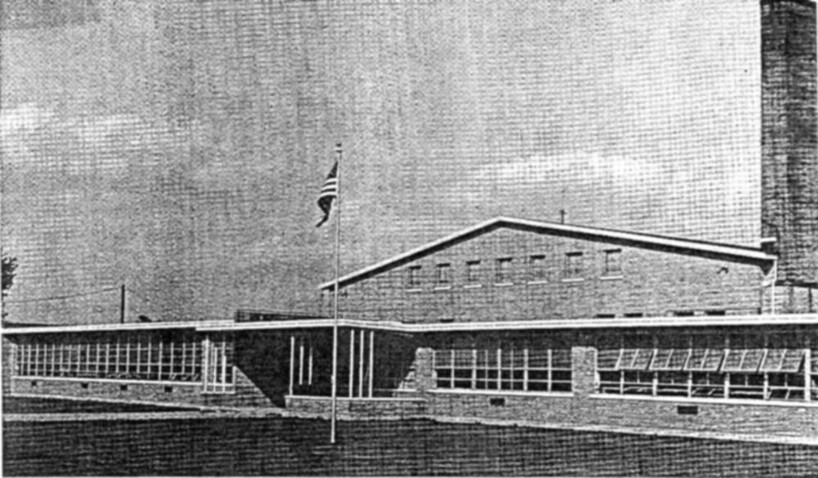
NEW MARKET HIGH SCHOOL, 1957-1971
As graduates of New Market School, we continue to be grateful to those who have encouraged us to do our best, inspired us to establish worthwhile goals, listened to our problems, tolerated our weaknesses, and helped us to adjust to society, in addition to imparting knowledge, which was their reason for being there. These are the teachers of NMHS and among those remembered for their faithful service are Molly Hall, 52 years; Paul A. Wilson, 38 years; Charles DeBusk, 36 years; Imogene Reddish DeBush, 34 years; Ethel Busenbark Quigg, 30 years; EP Cassidy, 22 years; Ruth Elmore Allison, 21 years and EO Kirkpatrick 20 years.
.... AND so the doors of New Market High School close.
